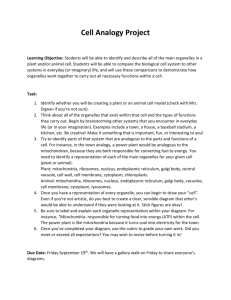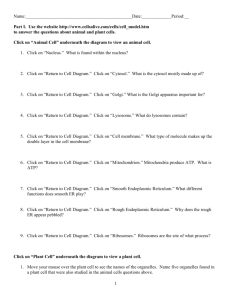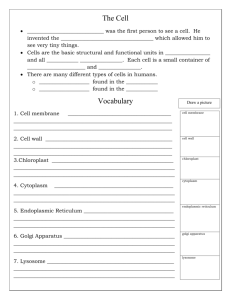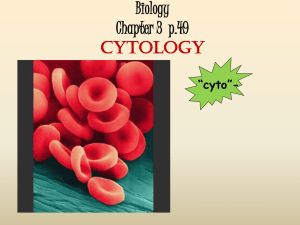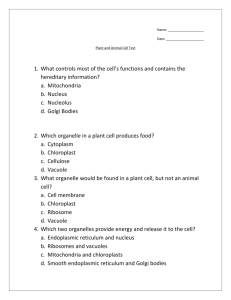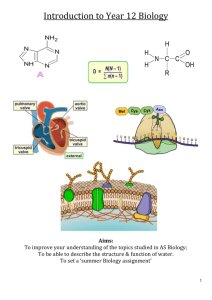File
advertisement
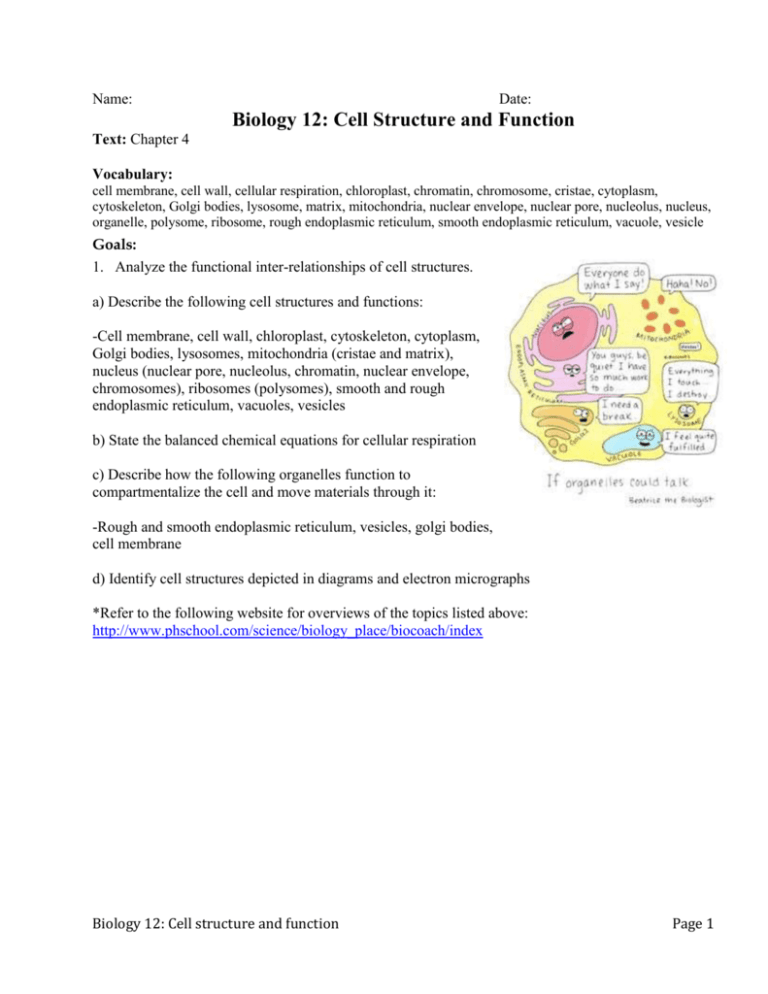
Name: Date: Biology 12: Cell Structure and Function Text: Chapter 4 Vocabulary: cell membrane, cell wall, cellular respiration, chloroplast, chromatin, chromosome, cristae, cytoplasm, cytoskeleton, Golgi bodies, lysosome, matrix, mitochondria, nuclear envelope, nuclear pore, nucleolus, nucleus, organelle, polysome, ribosome, rough endoplasmic reticulum, smooth endoplasmic reticulum, vacuole, vesicle Goals: 1. Analyze the functional inter-relationships of cell structures. a) Describe the following cell structures and functions: -Cell membrane, cell wall, chloroplast, cytoskeleton, cytoplasm, Golgi bodies, lysosomes, mitochondria (cristae and matrix), nucleus (nuclear pore, nucleolus, chromatin, nuclear envelope, chromosomes), ribosomes (polysomes), smooth and rough endoplasmic reticulum, vacuoles, vesicles b) State the balanced chemical equations for cellular respiration c) Describe how the following organelles function to compartmentalize the cell and move materials through it: -Rough and smooth endoplasmic reticulum, vesicles, golgi bodies, cell membrane d) Identify cell structures depicted in diagrams and electron micrographs *Refer to the following website for overviews of the topics listed above: http://www.phschool.com/science/biology_place/biocoach/index Biology 12: Cell structure and function Page 1 Every living thing is made of cells. -This unit we are moving up in the levels of cellular organization to see how the chemicals you studied in biochemistry work within the cell. -Examine a plant (moss or onion) and animal (human cheek cell) slide under high power. *You will need to use Methyl Blue stain for your cheek cells only. a) What parts of the cell do you remember from previous science classes? ____________________________________ ____________________________________ ____________________________________ ____________________________________ b) How are plant and animal cells different from each other? ____________________________________ ____________________________________ ____________________________________ ____________________________________ -Electron micrographs are used to see the components of cells in greater detail. More images can be found at: http://www.cellimagelibrary.org/ Biology 12: Cell structure and function Page 2 By studying many electron micrographs, we are able to see that a typical animal cell contains many small structures that are collectively called ___________________________________. Many of these organelles are bounded by ____________________, which separate the contents of the organelles from other parts of the cell. 3. Use your text to label the following diagram of a typical animal cell, and underline all organelles that are bounded by membranes. View the BioFlix on Animal Cells: Biology 12: Cell structure and function Page 3 4. Use your text to label the following diagram of a typical plant cell, underlining all organelles that are bounded by a membrane. View the BioFlix on Plant Cells: 5. List structures found in plant cells that are not found in animal cells: __________________________________________________________________________________ __________________________________________________________________________________ Biology 12: Cell structure and function Page 4 6. The entire region between the nucleus and the plasma membrane is called the ________________________________________________. The Nucleus 7. What are the main functions of the nucleus? ____________________________________________________________________________ ____________________________________________________________________________ 8. What is the function of the nucleolus? ____________________________________________________________________________ 9. Be able to identify each of the following components of the nucleus: chromatin, nuclear envelope, nuclear pores, nucleolus 10. What is the difference between chromatin and chromosomes? _______________________________________________________________________________ _______________________________________________________________________________ 11. What enters the nucleus through the nuclear pores? __________________________ What exits the nucleus through the nuclear pores? ___________________________ Biology 12: Cell structure and function Page 5 12. How many membranes make up the nuclear envelope? ____________ At some points, it can be seen that the nuclear envelope is joined to the ______________________________________________________. 13. What is the role of ribosomes in the cell? ___________________________________________________________________________ How do attached ribosomes differ from free ribosomes? ____________________________________________________________________________ ____________________________________________________________________________ Why are some ribosomes attached and some ribosomes free? ____________________________________________________________________________ ____________________________________________________________________________ What are polysomes (polyribosome)? ____________________________________________________________________________ ____________________________________________________________________________ Label this diagram of a polysome: Biology 12: Cell structure and function Page 6 The Endomembrane System 14. What is the endomembrane system and what are its main components? ____________________________________________________________________________ ____________________________________________________________________________ Other than social skills, what is the main difference between smooth and rough ER? (HA! I’m hilarious…) _________________________________________ _________________________________________ _________________________________________ _________________________________________ Describe three main functions of the smooth endoplasmic reticulum: (Sec 4.9 p 60) 1. _______________________________________________ ____________________________________________________________________________ 2. _______________________________________________ ____________________________________________________________________________ 3. ________________________________________________ ____________________________________________________________________________ 15. What are two main functions of the rough ER? 1. __________________________________________________________________________ 2. __________________________________________________________________________ Biology 12: Cell structure and function Page 7 Use your text and activity 4.13 to describe the steps shown in the following diagram of the synthesis of a secretory protein: _______________________________________ _______________________________________ _______________________________________ _______________________________________ _______________________________________ _______________________________________ ____________________________________________________________________________ ____________________________________________________________________________ What is the role of the transport vesicle in this process? _______________________________ ____________________________________________________________________________ Name two different secretory proteins that would be manufactured in this manner: ____________________________________________________________________________ 16. What are some functions of the Golgi apparatus. ____________________________________________________________________________ ____________________________________________________________________________ Biology 12: Cell structure and function Page 8 How does the Golgi apparatus work with the endoplasmic reticulum? ____________________ ____________________________________________________________________________ ____________________________________________________________________________ ____________________________________________________________________________ What is the role of the transport vesicle? ___________________________________________ 17. What is a lysosome ? ____________________________________________________________________________ ____________________________________________________________________________ List some functions of the lysosome: ____________________________________________________________________________ ____________________________________________________________________________ Label this diagram illustrating the formation of a food vacuole and the digestion of its contents by a lysosome: Name one type of cell in your body that would contain lots of lysosomes. Explain. __________________________________________________________________________________ __________________________________________________________________________________ Biology 12: Cell structure and function Page 9 Label this diagram illustrating the use of lysosomes to digest damaged organelles: What is a vacuole? __________________________________________________________________________________ __________________________________________________________________________________ What is the function of the central vacuole of a plant cell? _____________________________________________ _____________________________________________ _____________________________________________ _____________________________________________ _____________________________________________ You can see the contractile vacuole of a Paramecium at this website: Paramacium Vacuole Paramecium Exploding! How is the contractile vacuole of a Paramecium important to its survival? __________________________________________ __________________________________________ __________________________________________ Biology 12: Cell structure and function Page 10 Summary: The endomembrane system is an interconnected system of membranes that works together in synthesis, transport, storage and secretion. Label the following diagram to illustrate the various parts of the endomembrane system: View The Inner Life of the Cell from Harvard University on youtube. Energy Converting Organelles See Sec 4.14 and 4.15 Activity: Build a Chloroplast and a Mitochondrion (4.13) How are mitochondria and chloroplasts linked together? Express this in a formula. __________________________________________________________________________________ __________________________________________________________________________________ 1. Mitochondria -Mitochondrial matrix contains ____________, ______________ and __________________ to catalyze cellular respiration. -Inner membrane contains embedded proteins that function in ________ __________________ -Glucose hydrolysis begins outside of the mitochondria in the cell’s cytoplasm, with cellular respiration being completed inside the mitochondrial matrix. During cellular respiration, mitochondria produce molecules of _______________, which are used in the cell as an energy molecule for cell work. Biology 12: Cell structure and function Page 11 -What is an advantage of having a highly folded Inner Membrane? __________________________________________ __________________________________________ __________________________________________ __________________________________________ ___________________________________________ _________________________________________ *View Powering the Cell: Mitochondria 2. Chloroplast -Define the following terms using your text: a) Stroma: ____________________________________________ _____________________________________________________ _____________________________________________________ b) Thylakoids: ________________________________________ _____________________________________________________ _____________________________________________________ c) Granum: ___________________________________________ _____________________________________________________ _____________________________________________________ In living systems, matter moves in \ Biology 12: Cell structure and function Page 12 The Cytoskeleton (Sec 4.17) -The cell cytoplasm is a very busy place. Is it random chance that the vesicles released from the Golgi Apparatus navigate the many other organelles, enzymes and proteins to reach the cell membrane? ______________________________________ ______________________________________ ______________________________________ ______________________________________ List the three types of cytoskeleton fibres: __________________________________________________________________________________ Which of the cytoskeleton fibres are the thinnest? __________________________________ thickest? ___________________________________ Biology 12: Cell structure and function Page 13 Microfilaments: _____________________________________________________________________ __________________________________________________________________________________ Intermediate filaments: _______________________________________________________________ __________________________________________________________________________________ Microtubules: ______________________________________________________________________ __________________________________________________________________________________ Cilia and flagella are both cellular projections that can move because they contain ________________________________. Which molecule provides the energy for the cilia and flagella to move? ____________________ Activity: Cilia and Flagella (4.18) List some places in the human body where cilia are found: ________________________________________ ______________________________________________ What is the only cell in human body that has a flagellum? ___________________________________ This diagram shows the common structure of both the cilium and the flagellum: Biology 12: Cell structure and function Page 14


